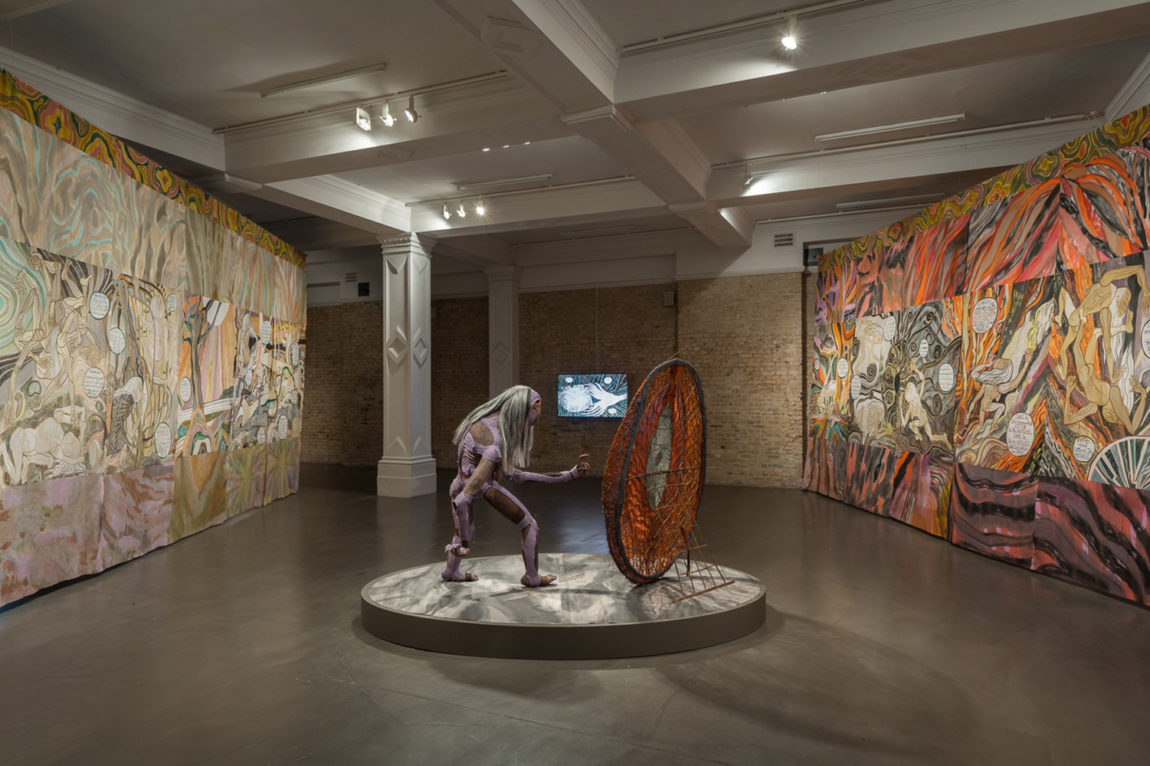Emma Talbot (1969), winner of the eighth edition of the Max Mara Art Prize for Women, presents a new body of works at the Whitechapel Gallery. The Age is composed of animations, painted and suspended silk panels, a three-dimensional work and some drawings. This new work explores themes such as representation and aging, power and governance and attitudes towards nature. For the Max Mara Art Prize for Women, Talbot imagines a future environment in which humanity faces the disastrous consequences of late capitalism and, in order to survive, must rely on more ancient and holistic methods of construction and belonging, methods that rework the ancestral structures of power and celebrate the natural world.

The exhibition is the result of a six-month period of residence in Italy, organized especially for her by the Maramotti Collection. After receiving the prestigious biennial award in 2020, Talbot traveled between Reggio Emilia, Catania and Rome dedicating himself to the study of textile craftsmanship, permaculture, classical mythology and exploring places and institutions of great historical interest that inspired the new corpus. of her works. The Age takes as its starting point the painting The Three Ages of Woman (1905) by Gustav Klimt, which Talbot was able to admire up close during her residence. Klimt portrays an elderly woman who supports her head with her face in her hands, in an expression of apparent shame. In her work of hers, Talbot reimagines this elderly figure as a woman endowed with will.

The central work of the exhibition is an animation in 12 chapters, whose protagonist must face a series of tests similar to the twelve labors of Hercules. In her stay in Rome, Talbot was able to study the depictions of ancient Etruscan ceramics, powerful vehicles of classical mythology, together with Valentino Nizzo, director of the National Etruscan Museum of Villa Giulia. Instead of overcoming the trials through destruction, theft, deception and murder (as Hercules did), the protagonist adopts practical, productive and care-centered solutions inspired by the 12 principles of permaculture, a method that allows you to coexist in ethical and sustainable way with the earth. By facing a series of challenges of our time, the protagonist has the opportunity to rebuild contemporary society, opposing negative attitudes in relation to aging, power and the climate crisis.

The exhibition also includes a selection of original drawings made by Talbot for her animations. The Age also includes two large suspended and hand-painted silk panels depicting unstable landscapes of near-future ruins and volcanic terrain that the protagonist explores and inhabits. As in most of his works, Talbot has brought back on the silk some writings focused on the themes of the exhibition, which invite visitors to question themselves about their perceptions in a direct way. The subjects of the works on silk are inspired by Talbot’s travels to Sicily, where the artist was able to visit volcanic landscapes and ancient ruins, studying the principles of permaculture at the Casa di Paglia Felcerossa.
The final element of The Age is a physical representation of the central figure of the elderly woman, in the form of a life-size sculpture made of soft, padded fabrics. Materials designed by the artist in collaboration with Imax, Max Mara’s knitwear division, were used to create the outer covering of the sculpture, which reproduces the wrinkles of old skin and looks almost like armor.

The Max Mara Art Prize for Women was born from a collaboration between Whitechapel Gallery, Max Mara and Collezione Maramotti. The prize has been awarded in alternate years since 2005 and is dedicated to female artists active in the United Kingdom who have not yet exhibited their works in a personal anthological exhibition. Recognized for its ability to advance the career of female artists, it is the only visual arts award of its kind in the UK.
On the occasion of the exhibition at the Whitechapel Gallery, a short documentary will be released that recounts Talbot’s experience during the six months of residence in Italy. After the presentation at the Whitechapel Gallery, The Age / L’Età will move to the Maramotti Collection in Reggio Emilia (23 October 2022 – 19 February 2023). Talbot has also been selected for the 59th International Art Exhibition of the Venice Biennale, entitled The Milk of Dreams / The Milk of Dreams, curated by Cecilia Alemani, which will be open until November 27, 2022.
The Age / L’Età
Max Mara Art Prize for Women: Emma Talbot
June 30 – September 4 2022





Comments are off this post!